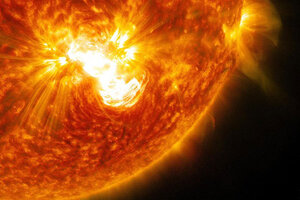Monster solar flare: Why is the sun acting up now?
The biggest sunspot in decades has unleashed a major solar flare, the fourth eruption of its kind in less than a week.

A massive X3.1 solar flare erupts from the giant sunspot AR 12192 on Oct. 24, 2014 in this close-up view from NASA's Solar Dynamics Observatory, a spacecraft that constantly watches Earth's nearest star.
NASA/SDO
The biggest sunspot on the face of the sun in more than two decades unleashed a major flare on Friday (Oct. 24), the fourth intense solar storm from the active star in less than a week.
The solar flare occurred Friday afternoon, reaching its peak at 5:41 p.m. EDT (2141 GMT), and triggered a strong radio blackout at the time, according to the U.S. Space Weather Prediction Center. NASA's sun-watching Solar Dynamics Observatory captured stunning video of the huge solar flare.
The flare erupted from a giant active sunspot known as AR 12192 and was classified as an X3.1-class solar storm — one of the most powerful types of solar storms on the sun — but it is not the first time the sunspot has made its presence known. [Biggest Solar Flares of 2014 in Photos]
"This is the fourth substantial flare from this active region since Oct. 19," NASA spokesperson Karen Fox wrote in a status update.
Indeed, on Sunday (Oct. 19), the sunspot fired off a major X1.1-class solar flare, then followed it up with an intense M8.7-class flare on Wednesday (Oct. 22) that was followed that same day by an X1.6 event.
Sunspots are regions of the sun forged by shifting magnetic fields that are cooler than their surrounding solar material, giving them their dark, blemish-like appearance.
Sunspot AR 12192 dwarfs the Earth and is comparable to Jupiter in its size, according to solar astrophysicist C. Alex Young with NASA's Goddard Space Flight Center, who described the sunspot in his blog The Sun Today.
The sunspot is the largest of its kind since November 1990, and is larger than a monster sunspot that spawned a series of major solar flares over Halloween in 2003, Young wrote.
And on Thursday (Oct. 23), the sunspot was hard to miss during a spectacular partial solar eclipse that was visible from North America. Many of the skywatchers who captured photos of the solar eclipse remarked on the surprising sight of a giant sunspot on the face of the sun.
"This was my first time photographing a solar eclipse and I was thrilled to capture the sunspots as well," skywatcher Mark Ezell of Austin, Texas, wrote in an email on Thursday.
X-class solar flares are the most powerful eruptions on the sun. When aimed directly at Earth, X-class flares can potentially pose a danger to astronauts and spacecraft in space, and interfere with navigation, radio and communications signals. M-class flares are ranked as moderate sun storms that can supercharge the Earth's aurora displays. There are also weaker classes of solar storms that have little effect on Earth, including C-class, B-class and even A-class storms.
"Solar flares are powerful bursts of radiation," Fox wrote in the NASA update. "Harmful radiation from a flare cannot pass through Earth's atmosphere to physically affect humans on the ground, however -- when intense enough -- they can disturb the atmosphere in the layer where GPS and communications signals travel."
But X-class solar storms can unleash massive amounts of power.
"An X2 is twice as intense as an X1, an X3 is three times as intense, etc.," Fox wrote.
Despite its sheer power, the X3.1 solar flare on Friday was not the biggest sun storm of the year. On Feb. 24, the sun erupted with a monster X4.9-class solar flare that has topped the solar events of 2014. Smaller X-class flares have occurred occasionally throughout the year.
Young also wrote that sunspot AR 12192 is the largest sunspot of the sun's current 11-year weather cycle, known as Solar Cycle 24.
Email Tariq Malik at tmalik@space.com or follow him @tariqjmalik and Google+. Od-Original article on Space.com.
- Attack of the Sun | Video Show
- Solar Quiz: How Well Do You Know Our Sun?
- Anatomy of Sun Storms & Solar Flares (Infographic)
- Massive Sunspot Blasts X3-Class Flare | Video
Copyright 2014 SPACE.com, a TechMediaNetwork company. All rights reserved. This material may not be published, broadcast, rewritten or redistributed.

